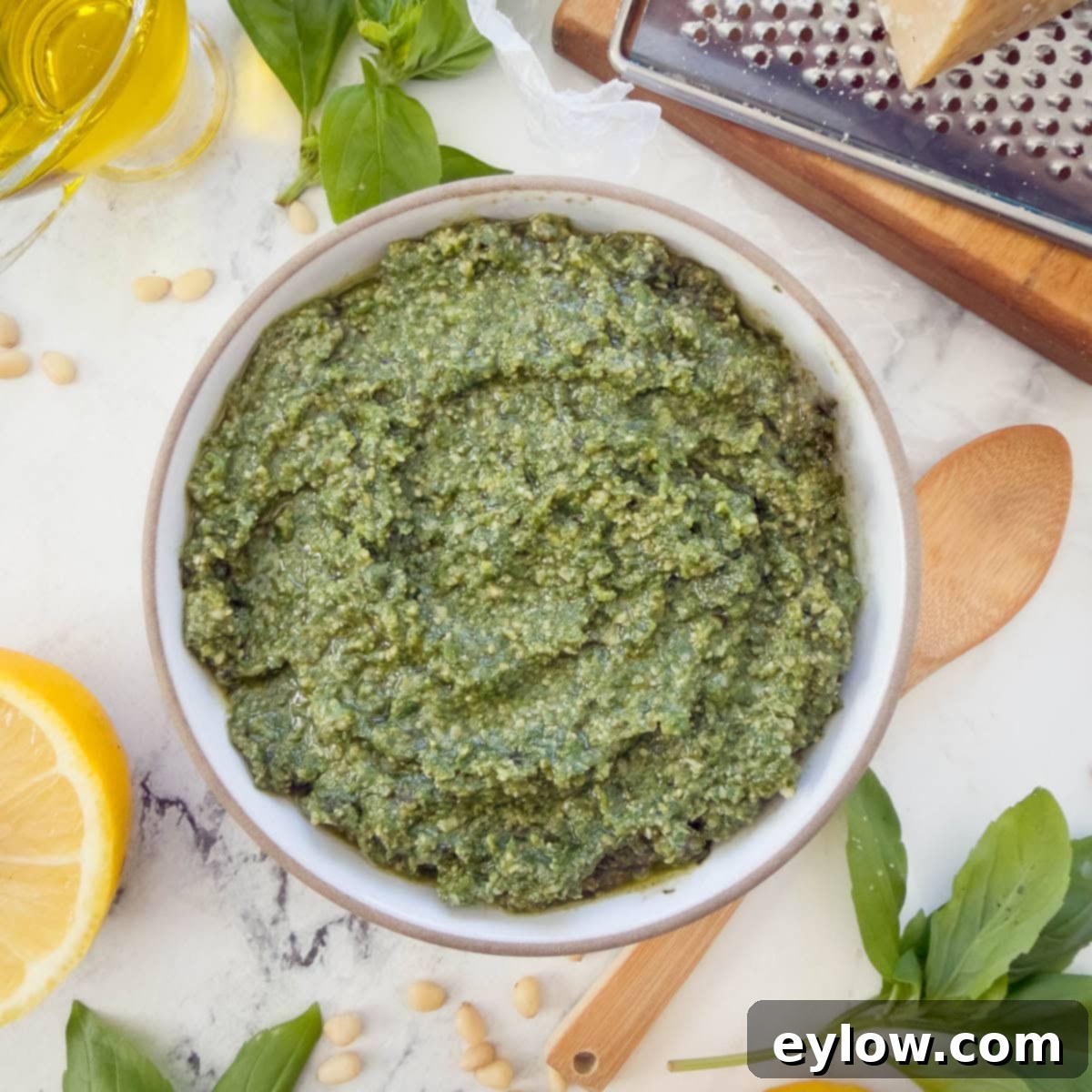The Ultimate Guide to Authentic Pesto Genovese: Crafting, Storing, and Enjoying Classic Italian Basil Pesto
Pesto Genovese, often referred to simply as Pesto alla Genovese, is the iconic basil pesto hailing from Genoa, the capital of Liguria, Italy. This vibrant green sauce is renowned for its ability to instantly elevate even the simplest dishes into culinary masterpieces. Crafted from a harmonious blend of fresh basil leaves, fragrant garlic, buttery pine nuts, salty Parmigiano Reggiano cheese, and rich extra virgin olive oil, it offers a bold, aromatic, and incredibly versatile flavor profile. In this comprehensive guide, we delve into not just my cherished recipe but also invaluable tips for preserving its vivid green color, effective freezing techniques, and an extensive collection of creative ways to incorporate this classic Italian staple into your everyday cooking.

Historically, the preparation of this exquisite Pesto Genovese recipe was a labor of love, traditionally performed using a mortar and pestle. The very word pesto derives from the Italian verb “pestare,” meaning “to pound” or “to crush,” a testament to its ancient origins. While the traditional method offers an undeniable authentic charm, it is often a slow process, typically yielding smaller batches, and, of course, necessitates the specialized tools. Having experienced both approaches, I can attest to the beauty of a hand-pounded pesto. However, for the demands of modern home cooking and ensuring consistent results, a high-quality food processor is my preferred tool for making basil pesto. It offers unparalleled speed, reliability, and still delivers a remarkably fresh, bold flavor, retaining the vivid, vibrant green hue that makes this basil sauce so appealing.
Why You’ll Fall in Love with Homemade Pesto Genovese
There are countless reasons why Pesto Genovese has captured the hearts and palates of food lovers worldwide. Here’s why this homemade version will become a staple in your kitchen:
- Unmistakable Bold Basil Flavor – This signature sauce from Genoa, Italy, is a celebration of fresh, fragrant basil. Unlike many store-bought varieties that can taste muted or overly cheesy, homemade pesto bursts with the vibrant, sweet, and slightly peppery notes of real basil, complemented by rich, savory undertones from the other ingredients. It’s an authentic taste that transports you straight to the Ligurian coast.
- Remarkably Quick and Easy to Prepare – Forget complicated recipes and lengthy cooking times. Made effortlessly in mere minutes with the aid of a food processor, this pesto recipe is perfect for busy weeknights or when you need a flavorful addition in a flash. The simplicity of its preparation belies the complexity of its taste.
- Incredibly Versatile for Endless Culinary Creations – Pesto Genovese is far more than just a pasta sauce. Its adaptability knows no bounds! Toss it with your favorite pasta for a classic meal, swirl it into a comforting bowl of minestrone soup, spoon it generously over grilled chicken or flaky salmon, or drizzle it over roasted or steamed vegetables. Personally, I find it absolutely exquisite when folded into a creamy risotto, adding a fresh, herbaceous dimension.
- Superior to Store-Bought Alternatives – Once you experience the unparalleled freshness and brightness of homemade pesto, you’ll rarely reach for a jarred version again. Our recipe uses fresh, high-quality ingredients without any of the preservatives or artificial flavors often found in commercial products. The difference in taste and aroma is truly transformative.
- Effortlessly Make-Ahead Friendly – Don’t let excess basil go to waste! This pesto is perfect for preparing in larger batches and freezing in convenient cubes or jars. This ingenious method allows you to capture basil’s fleeting summer flavor, ensuring you can enjoy a taste of sunshine all year long, even when fresh basil is out of season or expensive.
If your love for basil pesto runs deep, I encourage you to explore other delightful Italian variations. Give my Pesto Rosso (Sun-Dried Tomato Pesto) a try for a rich, sweet, and tangy alternative, or savor it in this comforting pesto rosso pasta dish. Each offers a unique twist on the beloved pesto tradition.
Essential Ingredients for Perfect Pesto Genovese
Crafting exceptional pesto begins with selecting the finest quality ingredients. Here’s a closer look at what you’ll need and why each component is crucial:
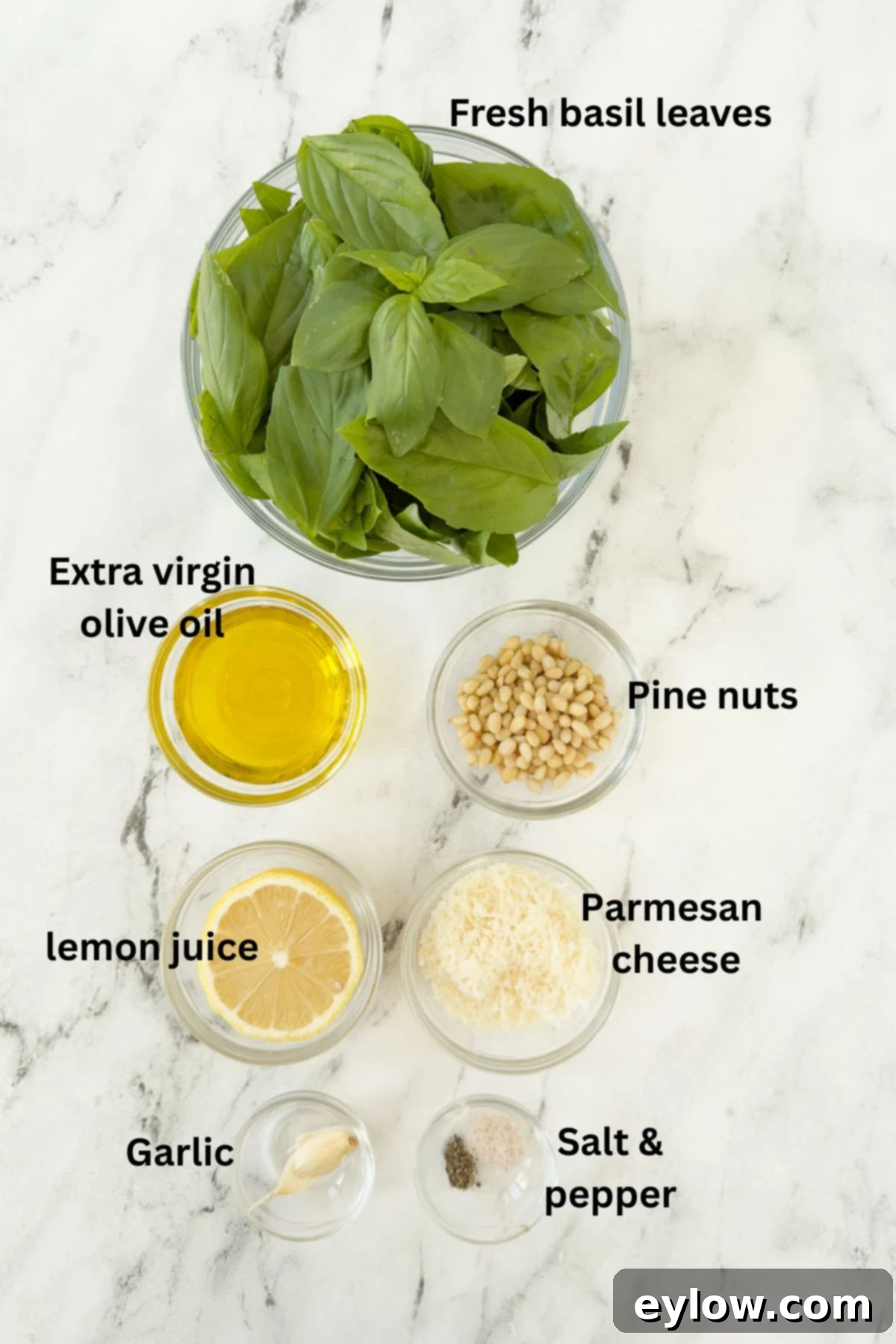
- Abundant Fresh Basil – The undisputed star of Genovese pesto sauce. For the most intense and authentic flavor, ensure you use plenty of vibrant, healthy basil leaves. Always discard the fibrous stems, as they can add bitterness and undesirable texture. Seek out Genovese basil if available, known for its sweet, less peppery flavor.
- High-Quality Extra Virgin Olive Oil – More than just a lubricant, a good quality extra virgin olive oil is paramount for both flavor and texture. It contributes a rich, fruity aroma and helps emulsify the pesto into a luxurious, silky smooth sauce. Choose a mild, fruity EVOO that won’t overpower the basil.
- Delicate Pine Nuts – These small, tender nuts are the traditional choice, lending a distinctive buttery, creamy body and subtle sweetness to the sauce. Lightly toasting them before use can enhance their nutty flavor (see below for substitution ideas if pine nuts are unavailable or too expensive).
- Authentic Parmigiano-Reggiano Cheese – For the absolute best flavor, grate your own cheese from a wedge of genuine Parmigiano-Reggiano. Its complex, salty, and umami notes are indispensable. While pre-grated Parmesan can be a time-saver, its flavor often pales in comparison and may contain anti-caking agents.
- Aromatic Fresh Garlic – Only fresh garlic cloves will do. Use just enough to provide a pungent, savory kick without overwhelming the delicate basil. Start with one clove and adjust to your preference.
- Fresh Lemon Juice (Optional but Recommended) – A small squeeze of fresh lemon juice is a modern enhancement that I wholeheartedly endorse. It brightens the flavor profile, provides a welcome counterpoint to the richness of the cheese and nuts, and also helps to preserve the pesto’s vibrant green color.
- Baby Spinach or Arugula (Optional for Color) – While not traditional, a handful of baby spinach leaves or a few sprigs of baby arugula can be a secret weapon for maintaining that stunning green color. They subtly enhance the color without significantly altering the authentic basil flavor.
For precise measurements of these ingredients, along with salt and pepper, please refer to the detailed recipe card at the end of this post.
Chef’s Tip – Mastering the Art of Keeping Pesto Vibrant Green
One of the most common challenges with homemade pesto is its tendency to brown quickly when exposed to air, a process known as oxidation. To preserve that irresistible, fresh green color, there are a couple of excellent tricks. Firstly, blending in a handful of tender baby spinach leaves or a few baby arugula sprigs can work wonders. Neither ingredient significantly alters the classic pesto flavor profile (though arugula might add a very slight peppery note). Secondly, a judicious squeeze of fresh lemon juice not only brightens the overall flavor but also acts as an antioxidant, helping to slow down oxidation. While these additions are not strictly part of a classic or traditional pesto sauce recipe, they serve a solid, practical purpose, ensuring your pesto looks as fresh and appealing as it tastes.
Pesto Genovese: Creative Substitutions and Flavorful Variations
While the classic Pesto Genovese is perfect as is, there’s always room for personalizing your sauce or adapting it based on what you have on hand. Here are some smart substitutions and exciting variations:
- Exploring Cheese Options – Beyond Parmigiano Reggiano, you can experiment with other hard Italian cheeses. Pecorino Sardo, a traditional sheep’s milk cheese from Liguria, is a historically accurate and flavorful choice. Grana Padano offers a similar nutty, savory profile to Parmesan. For a sharper, saltier kick, Pecorino Romano is another viable option, but use it sparingly as its intense flavor can easily dominate.
- Exciting Herb Twists – While basil is king, adding a small amount of other fresh herbs can introduce intriguing new dimensions. Incorporate a little fresh oregano for a more herbaceous, Mediterranean feel, or Italian parsley for a brighter, slightly peppery lift. A mix of basil and parsley is also a popular variation.
- Nut Substitutions for Pine Nuts – Pine nuts, while traditional and delicious, can be quite expensive. Walnuts are an excellent and readily available alternative, offering a robust, earthy flavor. For a milder, slightly sweeter pesto, consider using blanched almonds. Even cashews can work in a pinch, providing a creamy texture. If you’re looking for a nut-free option due to allergies, raw sunflower seeds or pumpkin seeds can provide a similar textural element and a mild, earthy taste.
Chef’s Tip – Blanching Basil for Unforgettable Brighter Green Pesto
For those moments when you desire a truly vivid, almost neon green pesto that maintains its stunning color for longer, blanching the basil leaves is a technique worth knowing. This process involves briefly immersing fresh basil leaves in rapidly boiling water for a mere 5-10 seconds. Immediately after, plunge them into an ice bath (a bowl of ice water) to halt the cooking process and set the chlorophyll. This quick thermal shock locks in that gorgeous, vibrant green color. Once blanched, drain the basil thoroughly and pat it completely dry before proceeding with your pesto recipe. While it adds a small extra step to the preparation, it’s a technique used by professional chefs to achieve that restaurant-perfect visual appeal and prolonged color stability. Give it a try when presentation is key!
Crafting Your Own Pesto alla Genovese: Step-by-Step
Making homemade pesto is a surprisingly simple and swift culinary endeavor. For effortless everyday cooking, a food processor is your best friend, yielding a consistently smooth and vibrant sauce. A blender can also be used, but extreme care is needed: pulse ingredients carefully and avoid over-blending. Excessive friction and heat generated by a blender can “cook” the delicate basil, causing it to lose its bright flavor and turn an undesirable brown color.
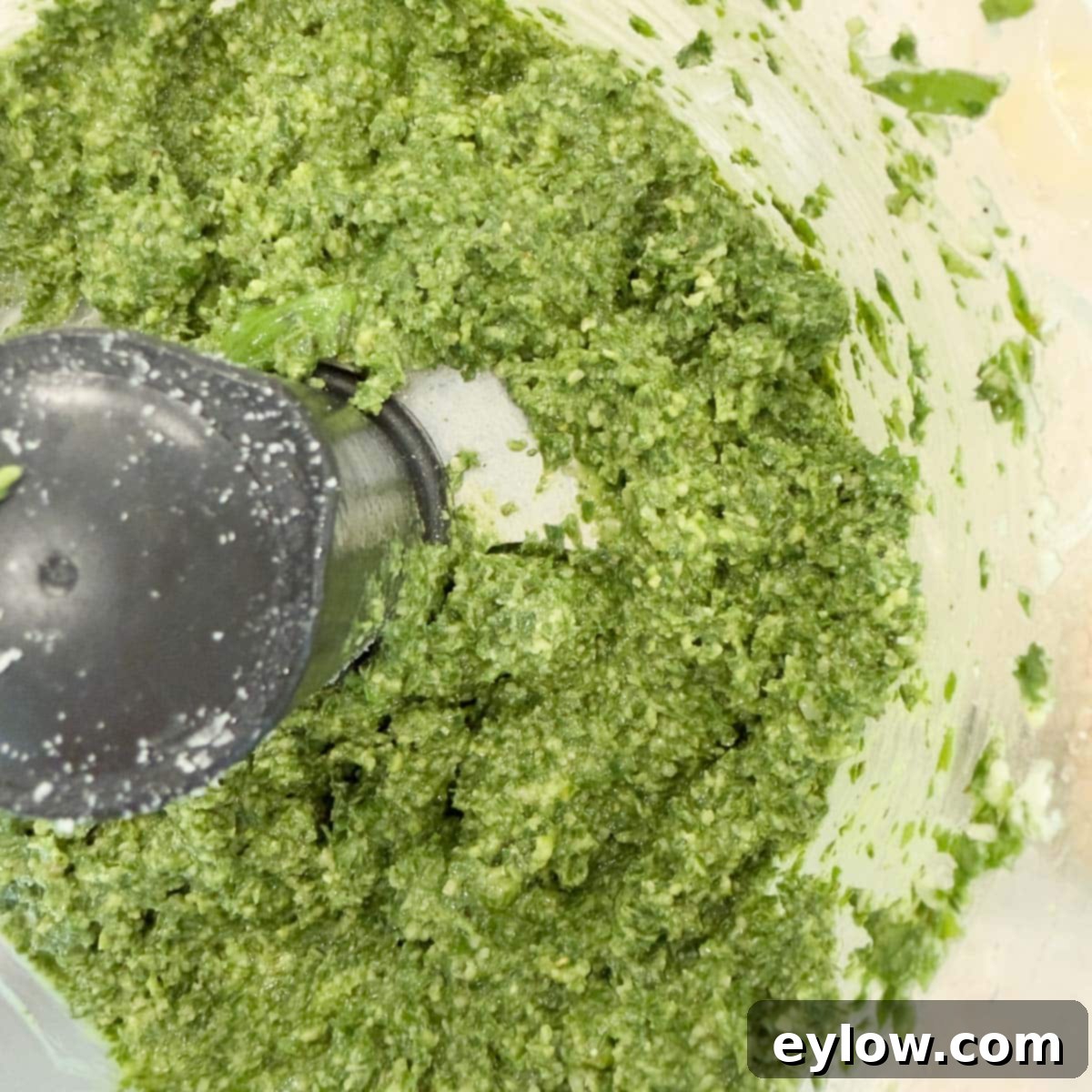
- Prepare the Garlic First: Begin by placing the peeled garlic clove into the feed tube of your food processor. With the machine running, drop the garlic through to ensure it is finely minced before adding other ingredients. This prevents larger chunks of garlic in your final pesto.
- Combine and Pulse: Once the garlic is minced, add all the remaining ingredients to the food processor work bowl: fresh basil leaves, pine nuts, grated Parmigiano Reggiano, extra virgin olive oil, and optional lemon juice, salt, and pepper. Pulse the mixture repeatedly. Avoid continuously running the motor, as this can generate heat. Pulse until the pesto reaches your desired texture – a few quick pulses for a rustic, chunkier pesto, or slightly longer for a smoother, creamier consistency.
- Taste and Adjust: After processing, taste your pesto. This is the moment to adjust seasoning. Add more salt if needed, a pinch of black pepper, or an additional squeeze of lemon juice to enhance brightness and balance the flavors.
Chef’s tip: Achieving the Perfect Pesto Consistency
The ideal pesto consistency is largely a matter of personal preference, but it should be pourable yet thick enough to coat pasta. If your pesto appears too thin or runny, you can easily thicken it by adding a little more fresh basil leaves, grated cheese, or a few extra pine nuts (or your chosen nut alternative), then pulsing again. Conversely, if your pesto is too thick or pasty, simply loosen it up with a small drizzle of additional extra virgin olive oil, a touch more lemon juice, or even a splash of cold water. Add these liquids gradually, pulsing between additions, until you achieve the desired smooth, emulsified texture.
Creative Ways to Serve Pesto Genovese

Beyond its classic pairing with pasta, the versatility of basil pesto knows no bounds. If you’ve ever wondered what else you can do with Pesto alla Genovese, the answer is “plenty!” Here are some of my all-time favorite, tried-and-true methods for incorporating this incredible sauce into various dishes:
Flavorful Vegetables & Sides Enhancements
- Pesto Mashed Potatoes: Elevate your ordinary mashed potatoes by stirring in a couple of tablespoons of pesto. The basil adds a fresh, herbaceous depth and a lovely green swirl, making them instantly more gourmet.
- Roasted or Steamed Vegetable Booster: Toss hot roasted red potatoes or freshly cooked green beans with a generous spoonful of pesto. It’s incredibly delicious whether served warm as a side dish or chilled in a summer salad. It also works beautifully with asparagus, broccoli, or bell peppers.
- Rich Pesto Risotto: Transform a creamy risotto into a vibrant, aromatic experience by stirring in a dollop of pesto just before serving. It infuses the rice with a wonderful basil flavor and a gorgeous color. This is an absolute favorite of mine.
- Easy Veggie Dip: Mix pesto with a little sour cream, Greek yogurt, or even mayonnaise to create a quick and easy dip for raw vegetables, crackers, or pita bread. It’s a simple way to add a burst of flavor to your snack platter.
Delicious Sandwiches & Starters Creations
- Gourmet Sandwich Spread: Ditch the conventional mayo or mustard and spread pesto generously on your turkey, chicken, or veggie sandwiches. It’s particularly delightful when pressed in a panini maker, allowing the flavors to meld beautifully.
- Homemade Pesto Aioli: Combine pesto with mayonnaise to create a sensational pesto aioli. This creamy, herbaceous condiment is fantastic for dipping French fries, spreading on burgers, or as a flavorful base for various sandwiches.
- Stuffed Portobello Appetizers: Spoon pesto into the caps of large portobello mushrooms before roasting. This makes for a hearty meatless main course or an impressive appetizer, especially when combined with other fillings like goat cheese or roasted tomatoes.
- Elegant Deviled Eggs Garnish: Add a tiny dollop of pesto atop your deviled eggs for an unexpected burst of flavor, a beautiful hint of green, and an added layer of sophistication.
Wholesome Soups & Fresh Salads Infusions
- Hearty Soup Swirl: Swirl a spoonful of pesto into classic soups like tomato soup, minestrone, or even a vegetable broth-based soup just before serving. It adds a depth of flavor and a fresh aroma that truly enhances the dish.
- Homemade Pesto Vinaigrette: Whisk pesto into your favorite vinaigrette recipe for a unique and flavorful pesto salad dressing. It’s fantastic with mixed greens, Caprese salads, or even grain bowls.
- Classic Caprese Twist: Dollop pesto onto slices of fresh tomatoes and mozzarella cheese for a delightful twist on a traditional Caprese-style salad. The pesto complements the sweet tomatoes and creamy mozzarella perfectly.
- Quick Pasta Salad Base: Toss cooked, chilled pasta with cherry tomatoes, fresh mozzarella balls, and a generous amount of pesto for a simple, refreshing, and incredibly flavorful pasta salad perfect for picnics or light lunches.
Savory Proteins & Decadent Sauces
- Simple Pesto Cream Sauce: Gently warm pesto with a splash of cream or milk to create a quick and luxurious pesto cream sauce. This is especially beautiful and incredibly delicious when spooned over freshly seared salmon, grilled shrimp, or chicken breast.
In terms of serving temperature, classic basil pesto’s complex flavors truly shine when it’s around room temperature. This allows all the aromatic compounds to be fully appreciated. However, a gently warmed pesto is also absolutely delicious, especially when incorporated into cooked dishes.
Storing & Freezing Homemade Basil Pesto for Year-Round Enjoyment
One of the best qualities of homemade pesto is its make-ahead potential, allowing you to enjoy the fresh taste of summer basil long after the season ends. Proper storage is key to maintaining its vibrant flavor and color.
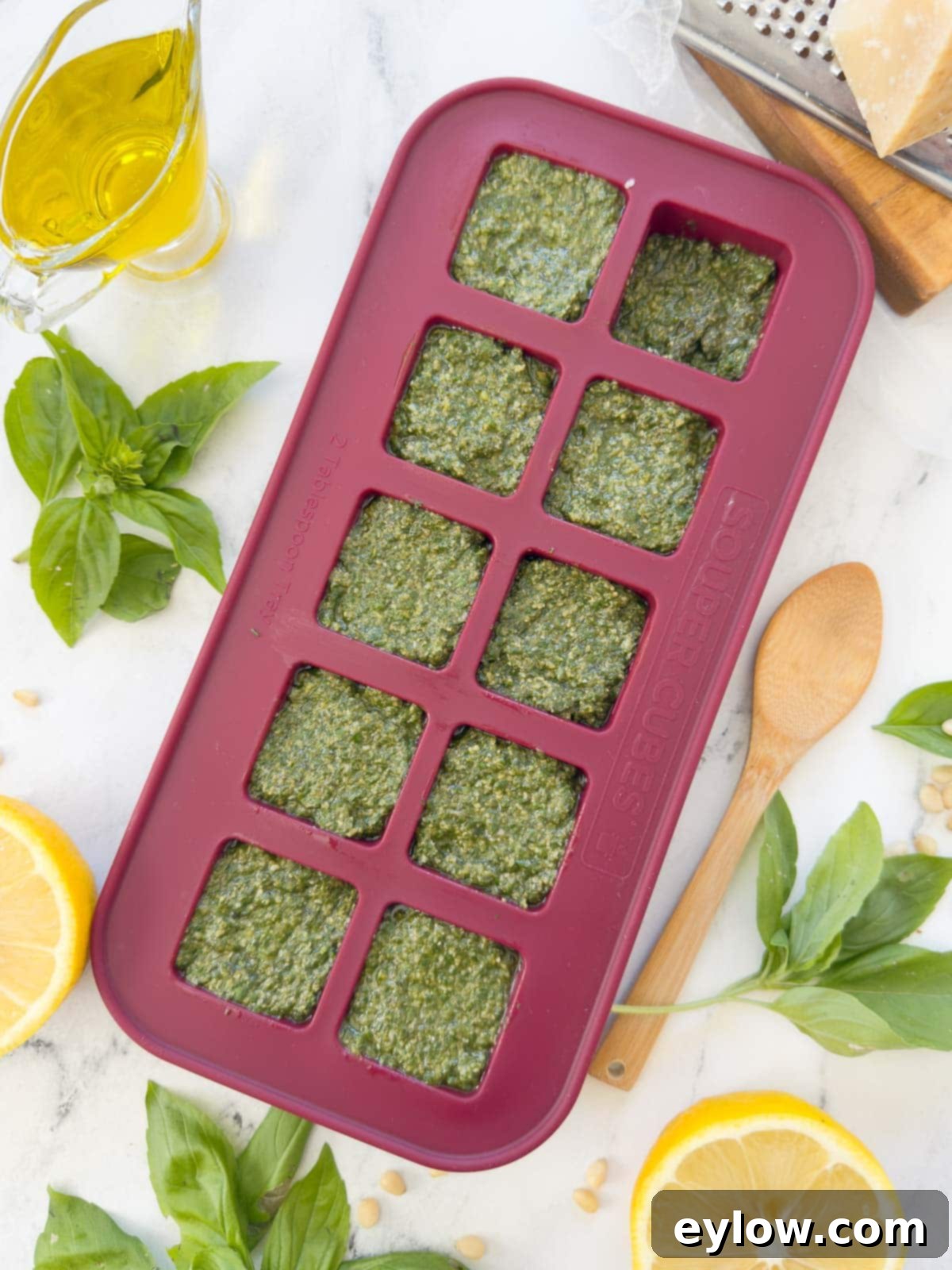
Refrigerator Storage
While homemade pesto is undeniably at its peak of freshness and most vibrant in color on the day it’s made, leftovers can be easily stored. Transfer any remaining pesto into a small, airtight container. It’s best to use a container that’s just large enough to hold the pesto, minimizing air exposure. For an extra layer of protection against oxidation and to help maintain its gorgeous green hue, drizzle a thin layer of olive oil on top of the pesto before sealing. This creates a barrier against the air. Stored this way, your fresh pesto will keep beautifully in the refrigerator for up to 3 days.
Freezer Storage
My absolute favorite method for long-term storage is freezing pesto. I love having a readily available stash of frozen pesto cubes – they are an absolute lifesaver for whipping up last-minute dinners or adding a burst of fresh basil flavor to any dish in seconds. Simply thaw what you need, and you’re good to go.
For optimal convenience and longer storage, portion your pesto into ice cube trays or specialized freezing trays like Souper Cubes, typically in 2-tablespoon portions. Once the pesto cubes are completely solid, pop them out of the trays and transfer them to a freezer-safe bag or an airtight container. This prevents freezer burn and makes them easy to access. Frozen pesto maintains its quality remarkably well for 2-3 months. Each cube (or two, depending on size) is often the perfect serving size for a single portion of pasta, or you can thaw 1-2 cubes to swirl into a creamy risotto or use as a vibrant garnish for soup, providing that delightful burst of fresh basil flavor whenever you desire.
Chef’s Tip – The Best Way to Thaw Frozen Pesto
When it comes to thawing your precious frozen pesto, there’s one golden rule: never microwave it! The intense, rapid heat of a microwave will dull its beautiful green color and significantly diminish its delicate flavor. Instead, opt for gentler thawing methods. Allow pesto cubes to thaw at room temperature for about 15-20 minutes for quick use, or transfer them to the refrigerator for a few hours (or overnight) for a more gradual thaw. If you’re incorporating pesto into a hot dish like soup or a simmering sauce, you can often stir a frozen cube directly into the warm liquid, where it will melt and blend seamlessly. However, for dishes like pasta or risotto, it’s best to thaw the pesto beforehand to ensure it blends smoothly and doesn’t cool down your perfectly cooked meal.
Frequently Asked Questions About Pesto Genovese
Pesto is highly susceptible to oxidation, which causes it to turn brown quickly upon exposure to air. To maintain that desirable bright green color, several factors are crucial. First, always use very fresh, vibrant basil. Second, ensure your olive oil is cold, and work quickly to minimize heat generated during blending. Avoid over-processing or continuously running the food processor; instead, use quick pulses. A splash of fresh lemon juice or blending in a handful of baby spinach leaves acts as a natural antioxidant, helping to preserve the color. For the most vivid and long-lasting green, consider the blanching method: quickly immerse basil leaves in boiling water for 5-10 seconds, then immediately plunge them into an ice bath, and pat them completely dry before blending. This extra step sets the chlorophyll and can make a noticeable difference.
For authentic Pesto alla Genovese, Parmigiano Reggiano is the gold standard due to its complex, nutty, and savory flavor. Sometimes, it’s traditionally combined with a portion of Pecorino cheese, such as Pecorino Sardo, which is a sheep’s milk cheese from Liguria, offering a sharper, more distinct profile. Using Parmigiano Reggiano alone will yield a perfectly delicious pesto. However, a blend of Parmigiano Reggiano and a smaller amount of Pecorino can introduce a more intricate and robust flavor. Pecorino Romano is another common substitute, but be mindful that it is notably saltier and has a much sharper flavor, so use it sparingly to avoid overpowering the basil.
Absolutely, you can. Classic Pesto Genovese traditionally features pine nuts, which contribute a distinct buttery texture and flavor. However, if pine nuts are unavailable, too costly, or if you prefer a different profile, walnuts are an excellent and popular alternative, offering an earthier taste. Almonds (preferably blanched) also work well for a milder, slightly sweeter result, and even cashews can provide a creamy consistency. If you need a completely nut-free pesto due to allergies, raw sunflower seeds or pumpkin seeds are fantastic options. While the flavor profile will subtly change with these substitutions, the core deliciousness of basil, olive oil, and cheese will still shine through, creating a wonderful pesto sauce.
Yes, freezing pesto is one of the best ways to preserve its fresh flavor and extend its shelf life. To freeze, simply spoon the freshly made pesto into ice cube trays or specialized freezer containers like Souper Cubes. Once the portions are completely frozen solid, you can transfer the cubes to a freezer-safe bag or an airtight container for more compact storage. Frozen pesto typically maintains its quality for 2-3 months. This method allows you to thaw just the amount you need, making it incredibly convenient for quick additions to pasta, enriching risottos, or garnishing soups.
Discover More Delightful Recipes Featuring Fresh Basil
If you’ve stocked up on fresh basil and are looking for more ways to enjoy its fragrant leaves, explore these delicious recipes. From refreshing salads to savory dips and elegant appetizers, these basil-infused dishes are perfect for making the most of your abundant herb harvest.
- Easy Caprese Skewers with Basil Vinaigrette
- Easy Watermelon Basil Salad with Feta Cheese
- Burrata Caprese with Fresh Tomatoes
- Avocado Dip with Yogurt and Fresh Basil
⭐️Did You Make This Recipe?
If you’ve had the pleasure of making this homemade Pesto Genovese, I would absolutely love to hear about your experience! Please take a moment to add your comment below and share your feedback. Your insights are truly valuable, and I always enjoy hearing from you. If you loved this classic basil pesto recipe as much as I do, please consider giving it a 5-star rating! Your ratings genuinely help other readers discover and enjoy this delicious recipe.
📖 Recipe
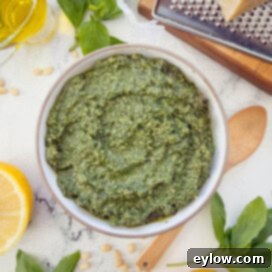
Pesto alla Genovese (Basil Pesto)
Sally Cameron
Pin Recipe
Equipment
-
Food Processor or a high-speed blender
Ingredients
- 2 cups fresh basil leaves, stems removed (approx. 2 ounces)
- ¼ cup finely grated Parmigiano-Reggiano cheese (or a mix with Pecorino)
- ¼ cup extra virgin olive oil
- 2 tablespoons pine nuts (or walnuts, lightly toasted if desired)
- 1 garlic clove (peeled)
- ⅛ teaspoon kosher salt
- 2 pinches black pepper (optional, to taste)
Optional Enhancements
- 2-3 teaspoons lemon juice (for brightness and color retention)
- ¼ cup baby spinach leaves or arugula (for enhanced green color)
Instructions
Mince Garlic
-
In a food processor fitted with the steel blade, drop the peeled garlic clove through the feed tube while the machine is running. Process until finely minced.
Combine Remaining Ingredients & Blend
-
Add the fresh basil leaves, pine nuts, grated Parmigiano-Reggiano, extra virgin olive oil, optional lemon juice, kosher salt, and black pepper to the food processor. Pulse the mixture until it reaches your desired consistency – a few quick pulses for a rustic, slightly chunky pesto, or longer for a smoother, creamier sauce. Be careful not to over-process, as this can generate heat and dull the basil’s color.
Adjust Consistency and Seasoning
-
Taste the pesto and adjust seasoning as needed. If the pesto is too thin, you can thicken it by adding a little more basil, cheese, or nuts. If it’s too thick, loosen it to your preference with a small drizzle of additional olive oil, a bit more lemon juice, or a splash of cold water.
Notes
Scrape the finished pesto into a small, airtight container, ensuring minimal air exposure. For extra protection against browning, drizzle a thin layer of olive oil over the surface before sealing. Refrigerate for up to 3 days. For longer storage, freeze pesto in ice cube trays or small jars; my preference is Souper Cube 2-tablespoon trays for convenient portioning. This allows you to enjoy fresh pesto flavor for months.
Nutrition
